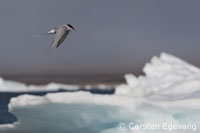The Amazing Migration of the Arctic Tern Visualized with Google Earth
 Bonn,
Bonn,
10 February 2012 - A new Google Earth Tour visualizing
the incredible migration of the Arctic Tern (Sterna
paradisaea) has recently been published by the Encyclopaedia
of Life (EOL). These small birds travel distances of more
than 71,000 km annually, from pole to pole, crossing through
temperate and tropical regions along the way.
The new web visualization presents a summary
of the research results of an international study published
in 2010 which successfully mapped the impressive migratory
movements of the Arctic Tern, using geo-locators - tiny
tracking devices mounted on the legs of the birds.
The results from this ground breaking study
not only confirmed the Arctic Tern as the champion of long-distance
migration, but also held a few surprises in store for the
research team. As the new visualization nicely shows, the
study also revealed some very interesting new insights with
regard to the migration patterns of the Arctic Tern.
It turns out that the birds did not immediately
travel south, but spent almost a month at sea in the middle
of the North Atlantic Ocean, approximately 1,000 km north
of the Azores. After this lengthy stop-over, the birds continued
their long journey south down the coast of northwest Africa,
but around the Cape Verde Islands the birds’ behaviour
surprised the research team again.
Approximately half of the birds continued down the coast
of Africa, while the other half crossed the Atlantic Ocean
to follow a parallel route south along the east coast of
South America.
The Arctic Tern is listed under AEWA (Table
1 / Column C / Category 1) and Appendix II of the Convention
on Migratory Species (CMS) and has a circumpolar breeding
distribution, breeding colonially in Arctic and sub-Arctic
regions of Europe, Asia and North America. It is a trans-equatorial
migrant, and can be found wintering throughout the Southern
Ocean to the edge of the Antarctic ice and the southern
tips of South America and Africa.
 |
 |
 |
The original study was carried out by a
team of researchers led by Carsten Egevang of the Greenland
Institute of Natural Resources with experts from Denmark,
the United States, the United Kingdom and Iceland. The results
of the study were first published in the U.S. journal Proceedings
of the National Academy of Sciences in January 2010. The
new EOL Google Earth Visualization is narrated by Ari Daniel
Shapiro and was produced by Atlantic Public Media (www.atlantic.org)
and Eduardo Garcia Milagros.
For more information see:
Last updated on 16 June 2014


